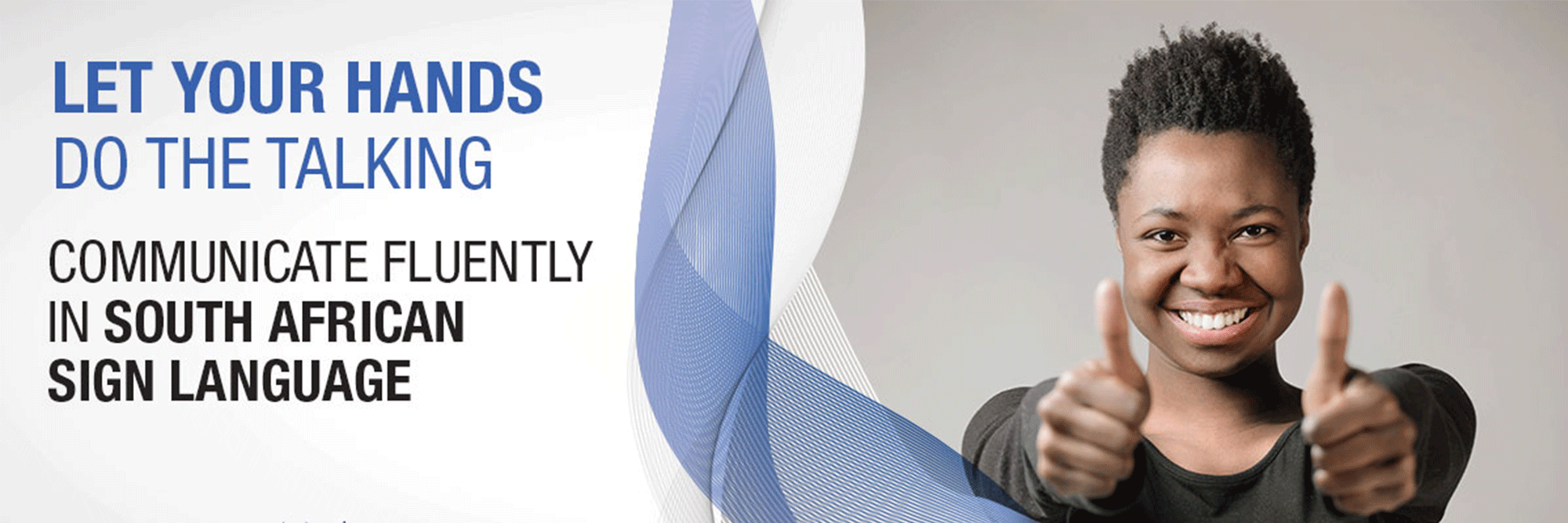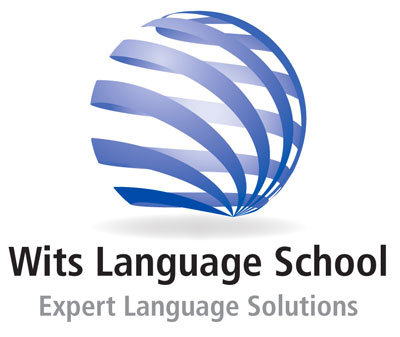
Learn how to Sign!
Learn to communicate and understand Deaf and hard of hearing people through the use of SASL
SASL is a valuable language. South Africa needs more people who are fluent users of SASL and have an appreciation of Deaf culture. SASL is a complete language with its own grammar, vocabulary and syntax. Like any other language, SASL is capable of communicating a potentially infinite number of ideas.
SASL is a first language for the Deaf community, but there are hearing people who communicate through sign language with children, friends and family who are deaf.
Sign language is now recognised as South Africa’s twelfth official language - view the SASL timeline.
Our courses have trained facilitators, who are first language proficient and have been further trained to teach hearing and non-hearing students.
-
South African Sign Language Level 1A
This course, the first of two modules at Level 1, provides an introduction to SASL to be used for general, basic communication. By the end of the course, participants will be able to:
- Use limited SASL vocabulary but correct finger spelling and basic sign language structure.
- Interact in SASL in a simple way, using simple phrases to describe, discuss and ask about everyday topics, as well as topics associated with areas of immediate need (including greetings, talking about the family, occupations, daily routines and social arrangements).
- Ask and answer questions.
- Engage in short conversations with a Deaf person and groups on a familiar topic using South African Sign Language (SASL) (NQF level 4, 6 credits)
- Demonstrate the production and reception of one hand finger-spelling alphabet (NQF level 4, 4 credits)
-
South African Sign Language Level 1B
This course is the second module of the introductory course in SASL at Level 1 to be used for general, basic communication with signers of the language. By the end of the course, students will be able to:
- Describe familiar people, places and events, holiday destinations and the weather.
- Ask about and give personal descriptions of oneself and others,express likes and dislikes, and ask for and give directions
- Request information and permission.
- Conduct short personal interactions.
- Deliver a monologue of not less than three minutes on familiar topics, such as personal information, social information, and/or general information about people and things within the person’s own experience, or specific situations or topics that have been well rehearsed.
- Deliver a monologue to a known audience on a familiar topic using SASL (NQF level 4, 10 credits)
- Perform everyday communicative tasks using SASL (NQF level 4, 4 credits).
-
South African Sign Language level 2A
This is a pre-intermediate course at Level 2A to be used in general, simple communication with signers of SASL. At the end of the course, students will be able to:
- Communicate and maintain short conversations to describe events, people and objects in simple terms and maintain communication that deals with the direct exchange of information, as well as the recounting of a signed conversation
- Understand specific predictable information in everyday conversations on a familiar topic
- Understand short, simplified signed monologues
- Ask questions about a signed monologue on a familiar topic, in preparation for paraphrasing it
- Summarise the main points of a short simple, signed text, using role shift where necessary.
- Recount a signed conversation on a simple topic, using South African Sign Language (NQF level 5, 4 credits)
- Paraphrase and summarise signed monologues on familiar topics using South African Sign Language (NQF level 5, 4 credits)
-
South African Sign Language level 2B
This is an intermediate course at Level 2B to be used for general and specific communication with users of the language. At the end of the course, the student will be able to:
- Hold conversations with Deaf individuals and groups of Deaf people, on familiar and unfamiliar topics and activities.
- Use a series of correctly-structured phrases to describe family and other people, living conditions, educational background and current or most recent job.
- Maintain communication that deals with both direct and indirect exchange of information.
- Explain complex processes to Deaf individuals and groups of Deaf people using SASL.
- Understand the main point of short, clear visual input, such as short, signed conversations.
- Understand specific predictable information in everyday signed conversations, as well as short, signed monologues that deal with unfamiliar topics.
- Hold conversations with Deaf individuals and groups of Deaf people on an unfamiliar topic using SASL (NQF level 5, 6 credits).
- Explain complex processes to Deaf individuals and groups of Deaf people, using South African Sign Language (NQF level 5, 3 credits).
-
South African Sign Language level 3A
This course, the first of two modules at Level 3, aims to enable participants to engage in specific sustained communication with users of the language in South African Sign Language at upper-intermediate A level, including making complex arrangements and engaging in sustained communication regarding the Deaf community and technology, services and education for the Deaf. At the end of the course, the student will be able to:
- Communicate regarding specific concrete and abstract tasks requiring a sustained exchange of information on topics and activities using SASL.
- Use a series of correctly structured phrases to discuss a practical problem and offer a solution using SASL.
- Describe and facilitate the completion of complex arrangements with Deaf individuals and groups of Deaf individuals.
- Demonstrate understanding of sustained signed conversations relating to areas of general relevance as well as unfamiliar topics that are delivered clearly by first-language signers.
- Build on previous knowledge of Deaf culture acquired up to intermediate level, and demonstrate knowledge of technology, services and education for the Deaf in South Africa.
- Make complex arrangements with Deaf individuals and groups of Deaf people, using South African Sign Language (NQF level 5, 3 credits).
- Discuss a practical problem and offer a solution, using South African Sign Language (NQF level 5, 3 credits).
- Demonstrate knowledge of Deaf Culture, the Deaf community and technology, services and education for the Deaf in South Africa (NQF level 4, 8 credits).
-
South African Sign Language level 3B
This is the second module of an upper intermediate course (at Level 3B), which aims to enable participants to engage in specific sustained communication in South African Sign Language, including delivery of a variety of prepared presentations on unfamiliar topics. At this level, the learner has comprehensive knowledge of the most important language structures. At the end of the course, the student will be able to:
- Deal with most situations likely to arise when speaking to first language speakers on familiar topics, i.e. enter unprepared into conversation.
- Ask questions and paraphrase a signed monologue on an unfamiliar event or topic using a series of correctly structured phrases.
- Summarise the main points of a signed text on an unfamiliar topic using South African Sign Language.
- Deliver a variety of prepared presentations and answer questions relating to an unfamiliar event or topic using South African Sign Language.
- Demonstrate understanding of sustained signed conversations and monologues relating to abstract and/or unfamiliar topics or events.
- Narrate a story or relate the plot of a book or film and describe their reactions.
- Understand the main points of signed TV programmes on current affairs or topics of personal or professional interest, including fictional narratives.
- Deliver a variety of prepared presentations and answer questions related to an unfamiliar topic using South African Sign Language (NQF level 5, 4 credits).
- Paraphrase and summarise a signed presentation on an unfamiliar topic using South African Sign Language (NQF level 5, 5 credits).
-
Course Fee
Courses 1A to 3B is R8 300 (this fee is per module for 1A to 3B).
Classes are subject to a minimum of 8 students. We reserve the right not to run a particular course in an intake if there is insufficient demand.
-
Duration
Each module is part-time and runs for 10 weeks (40 hours).
-
Qualification
Participants must complete two sets of assessments, formative and summative, in order to receive a Certificate of Competence.
-
Entry Requirements
Please ensure you meet the following requirements when applying for the course:
- 18 years or older
- Fluency of mother tongue language
- Placement tests are available for applicants who have previous experience of the language. (Assessment is conducted on registration)
- To qualify for a progressive module, you must complete the previous module. i.e. to do module 2A, you need to have successfully completed 1B or a placement test.
-
Application Process
Step 1: Complete the WLS Application Form
Step 2: Certify a copy of your ID.
Step 3: Email your completed Application form and certified copy of ID to wls@wits.ac.za
Step 4: Upon receiving your invoice and confirmation of registration on the course, please send us the proof of payment.
*Note that the course must be paid upfront as we do not offer payment installments.*

